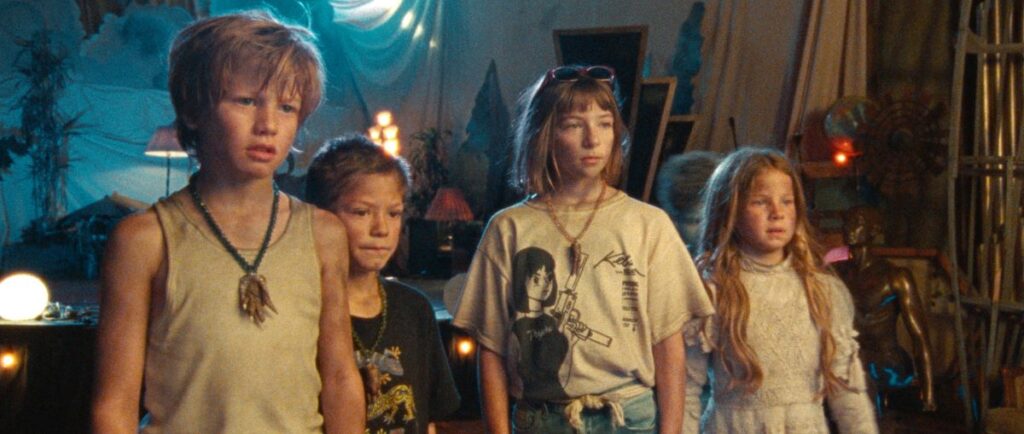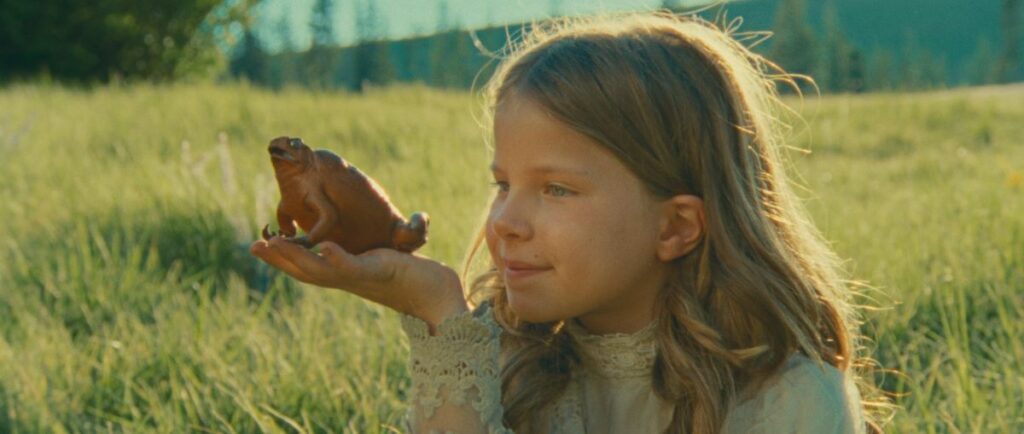One of the sacrifices one makes as a film critic who keeps up on current releases, particularly in the underground or independent sphere, is that it’s difficult to truly be surprised by a new film. To be clear, there’s no shortage of strange and wonderful new discoveries– this year has already seen a bumper crop, from Hundreds of Beavers to Sasquatch Sunset to The People’s Joker– but even at these films’ most outrageous one can sense the larger picture from whence they sprang. Every once in a while, however, I see a film which makes me squint my eyes, lean closer to the screen, and ask myself, “What is this?!” I don’t have an easy answer to that question with regard to Riddle of Fire, first-time director Weston Razooli’s deeply odd children’s adventure which commences a 35mm run at the Brattle this weekend. All I can say is that I’m enamored, and I want to see more of whatever it is.
Fittingly for a film about precocious children on a wild adventure, any description of Riddle of Fire’s plot will inevitably scan as a sugar-buzzed flight of fancy. The film follows “The Three Immortal Reptiles,” a trio of moppets (brothers Hazel and Jodie and their friend/leader Alice) who spend their days riding their tiny dirtbikes around the mountain village of Ribbon, Wyoming. After successfully purloining a video game system from a warehouse, our heroes hit a snag when they discover newly installed parental controls on the brothers’ TV. Their mother is sick (nothing serious, it seems, but a particularly nasty cold), and she relents and agrees to grant them two hours of TV time if they can provide her with a blueberry pie. One thing leads to another: to make the pie, they need to acquire the recipe; to follow the recipe, they need a speckled egg (“for good luck”); to get the egg, they need to trail a coven of taxidermist witches on a quest to capture the mountain’s legendary elk; and so forth.
The first thing you need to understand about Riddle of Fire and its peculiar appeal is that everything about it feels as if it were made by hand; the second is that it’s difficult to tell whether those hands belong to a human from earth. The look of the film somewhat recalls those half-remembered live-action Disney films from the ‘70s, its canyons and forests shot on gorgeously oversaturated 16mm. The film’s internal grammar, however, seems like it was built from scratch. Subtitles appear sporadically, occasionally accompanied by inscrutable glyphs, to vaguely describe the characters’ actions and rituals or spell out their incantations. Little touches, such as the interface of the children’s smart TV, seem like they were designed from thirdhand descriptions rather than devices the filmmakers interact with every day. Several roles in the opening credits are attributed to someone or something called “Anaxia.”* The result is something which feels not quite of this world, as if the film itself slipped in accidentally from another realm. The film operates on a wavelength all its own, and I was thoroughly enchanted.
It’s also one of the funniest films I’ve seen this year– though, again, in a way difficult to describe. The tone here falls somewhere between the deadpan absurdism of Quentin Dupieux and the hyperactive whimsy of Adventure Time or Over the Garden Wall. Much of the film’s humor comes from its young stars, who are clearly having the time of their lives. Their lines are delivered in the joyous, declamatory nature of funny kids who know they’re saying something funny, and are delighted that they get to say it (they also get to swear far more than in a conventional children’s film, referring to the witches’ tracker almost exclusively as “that woodsy bastard”). These are not polished performances by any stretch– young Jodie delivers his lines with such a real-kid mumble that he is subtitled throughout– but they are masterful in their own way. Untrained child actors tend to freeze up on camera; the fact that these performances were captured so effortlessly is a testament to both the actors and their director.

With its wide-eyed wonder and flights of earthy psychedelia, it would not be a stretch to refer to Riddle of Fire as “Stranger Things on mescalin.” However, unlike most recent works of Amblinsploitation, this is pointedly not a period piece. The film has such an out-of-time feel that it comes as a bit of a shock whenever a character produces a smartphone (in one of the funniest gags, when all seems lost and the kids are stranded in the middle of the woods in the dead of night, Alice checks to see how much an Uber home would cost). This is not “our” world by any stretch– I certainly don’t know so many people with such a matter-of-fact belief in magic– but there are just enough references to things like gas stations and poaching laws to make it recognizable. The warehouse the kids break into at the beginning of the film is clearly meant to be an Amazon analogue, yet it still comes off as strange and mysterious. We do not live in very magical times; that Razooli manages to find wonder in this sort of suburban banality is something of a conjuring act in its own right.
At nearly two hours, Riddle of Fire does come close to wearing out its welcome; its similarity to a children’s game of make-believe extends to the way in which those games tend to continue until all involved are exhausted. But my litmus test for whether a film is too long is to ask myself, “Do I wish there were less of this film?” In the case of Riddle of Fire, the answer is an emphatic no. The tactile pleasures of this film are so appealing that I could live in its world for days, from its soft-focus visuals to its expertly curated soundtrack of dungeon synth (there are also a pair of surprising needledrops toward the end of the film; one of them, plucked from the soundtrack to a film VERY much not for children, nearly made me fall out of my chair). It also can’t be said that the film runs out of surprises; in the third act, the children venture into a bizarre underworld venue which looks like a cross between the Twin Peaks Roadhouse and the Cambridge Antique Market. Weston Razooli has instantly proven himself to be one of our great crackpot visionaries, and I truly hope to hear more from him soon.
* – Anaxia is the title of a 2018 short film by Razooli, which can be viewed in its entirety on Youtube and which shares much of Riddle of Fire’s aesthetic. It is also described in the film’s press notes as Razooli’s “atelier,” making “films, books, clothing, and curios.” That I can find little evidence online of any of these other ventures simply adds to the mystique.
Riddle of Fire
2023
dir. Weston Razooli
113 min.
Screening on 35mm Thursday, 4/25 through Sunday, 4/28 @ Brattle Theatre – click here for showtimes and ticket info.



